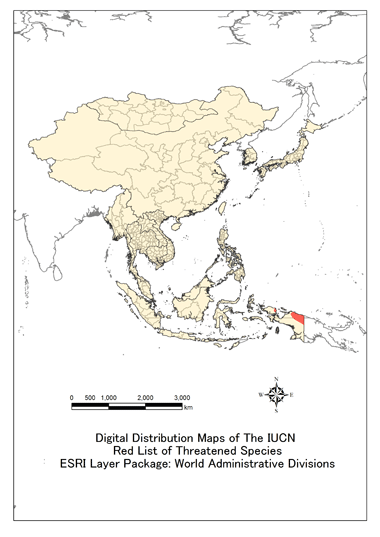
TOP > 生物多様性センターの国際協力 > ESABII > Database > Threatened Mammal Species Database > Spilocuscus rufoniger

Spilocuscus rufoniger
Taxonomy (Name)
| Class | MAMMALIAIUCN | |
|---|---|---|
| Order | DIPROTODONTIAIUCN | |
| Family | PHALANGERIDAEIUCN | |
| Scientific Name | Spilocuscus rufonigerIUCN | |
| Author | Zimara, 1937IUCN | |
| Synonyms | ||
| Common Name | Black-spotted CuscusIUCN | |
| Local name | Brunei Darussalam | |
| Cambodia | ||
| China | ||
| Indonesia | Kuskus (semua jenis dari genus Phalanger) | |
| Japan | ||
| Lao PDR | ||
| Malaysia | ||
| Myanmar | ||
| Mongolia | ||
| Philippines | ||
| Singapore | ||
| Republic of Korea | ||
| Thailand | ||
| Vietnam | ||
Picture
Distribution, Range
This species is widespread, though patchily distributed, in the northern part of the island of New Guinea (Indonesia and Papua New Guinea). Most of the records are very old. It has been recorded from sea level to 1,200 m asl.
Map


Country
| Brunei Darussalam | |
|---|---|
| Cambodia | |
| China | |
| Indonesia | |
| Japan | |
| Lao PDR | |
| Malaysia | |
| Myanmar | |
| Mongolia | |
| Philippines | |
| Singapore | |
| Republic of Korea | |
| Thailand | |
| Vietnam |
Status
International Status
IUCN Red List Category
CRIUCN
Justification
Listed as Critically Endangered because of a suspected population decline in excess of 80% over three generations (i.e., 15 years) (the last five years and next ten years) due to levels of exploitation and habitat loss (especially oil palm concessions and logging concessions).
CITES
CMS
National Status
| Country | Category | Reference |
|---|---|---|
| Brunei Darussalam | ||
| Cambodia | ||
| China | ||
| Indonesia | ||
| Japan | ||
| Korea | ||
| Lao PDR | ||
| Malaysia | ||
| Mongolia | ||
| Myanmar | ||
| Philippines | ||
| Singapore | ||
| Thailand | ||
| Vietnam |
Ecology Discription
Appearance
Habitat
This species prefers primary lowland and lower-montane tropical forests. It is also less commonly found in secondary forest. It is most likely nocturnal (L. Salas pers. comm.).
Population size
Spilocuscus rufoniger is a rare species. It has been extirpated from parts of its range through overhunting and its intolerance to human disturbance.
Behavior
Diet
Reproduction
Threat
Major Threat(s)
This species is threatened by preferential hunting by local people for food and cultural reasons, and also by conversion of forest to cultivated land. While it has declined where it comes into contact with people, a large part of its range is uninhabited. The west Papuan area has been impacted by the influx of Javan people, and large areas of habitat have been transformed by agriculture. There are also logging concessions and oil palm activities planned for parts of the area.
Conservation and Measurement
International
National
There is a need to conserve important populations of this species. Public awareness and hunting restrictions will be essential for the conservation of this species. Further research into its numbers, distribution, ecology, threats, harvest levels, and conservation measures are all important.
Conservation law
| Country | Status | Reference |
|---|---|---|
| Brunei Darussalam | ||
| Cambodia | ||
| China | ||
| Indonesia | ||
| Japan | ||
| Korea | ||
| Lao PDR | ||
| Malaysia | ||
| Mongolia | ||
| Myanmar | ||
| Philippines | ||
| Singapore | ||
| Thailand | ||
| Vietnam |
Protected Area
It occurs in several protected areas in Indonesia and a management area in Papua New Guinea.
Other Coservation Projects
Citation
Flannery, T. F. 1995. The Mammals of New Guinea, 2nd edition. Reed Books, Sydney, Australia.
IUCN. 2008. 2008 IUCN Red List of Threatened Species. Available at: http://www.iucnredlist.org. (Accessed: 5 October 2008).
